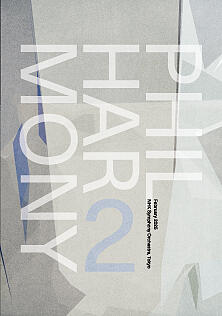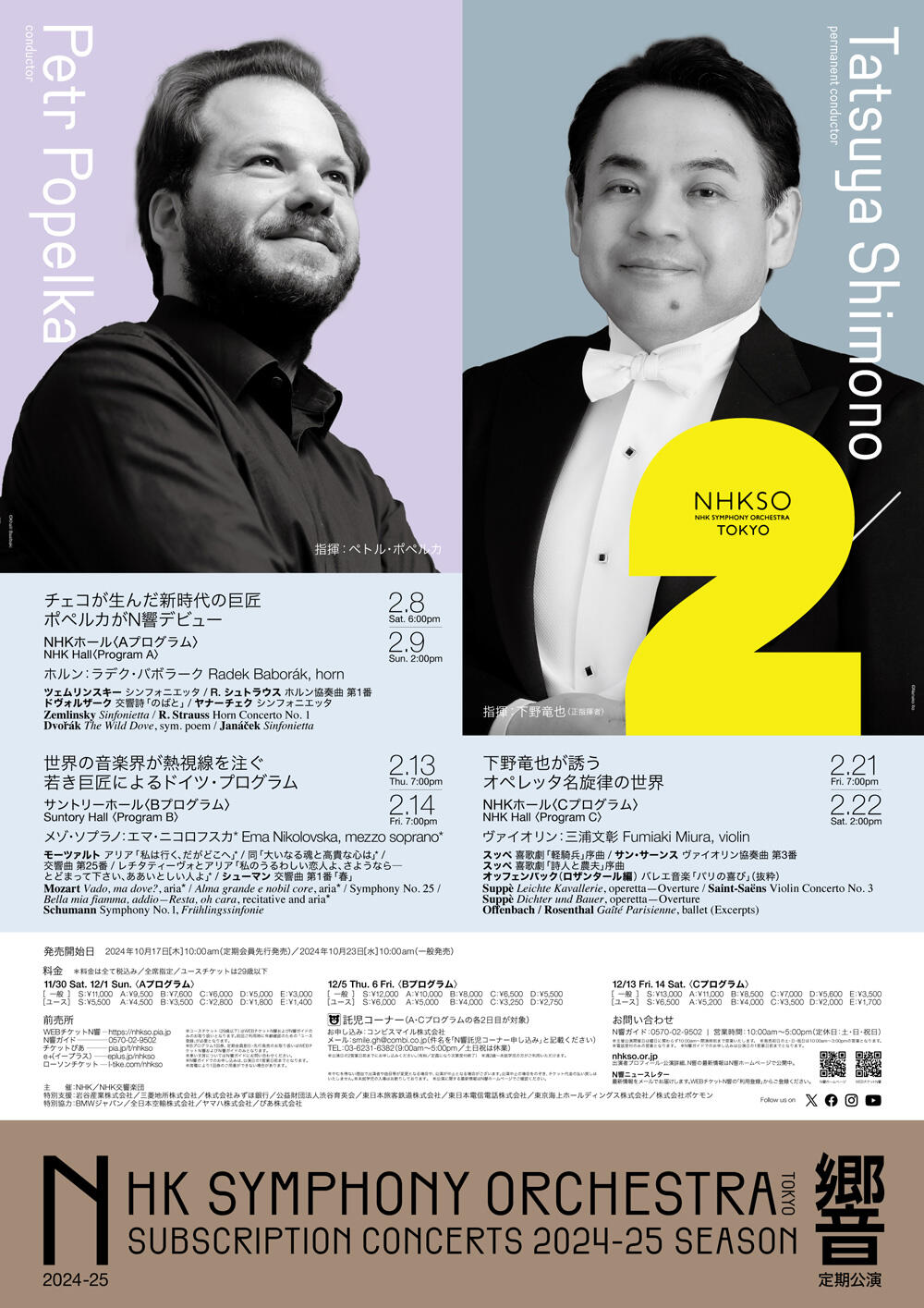- Home
- Concerts
- Subscription Concerts 2024-2025
- Program C
- No. 2033 Subscription (Program C)
No. 2033 Subscription (Program C)
NHK Hall
Google Map Seating Chart
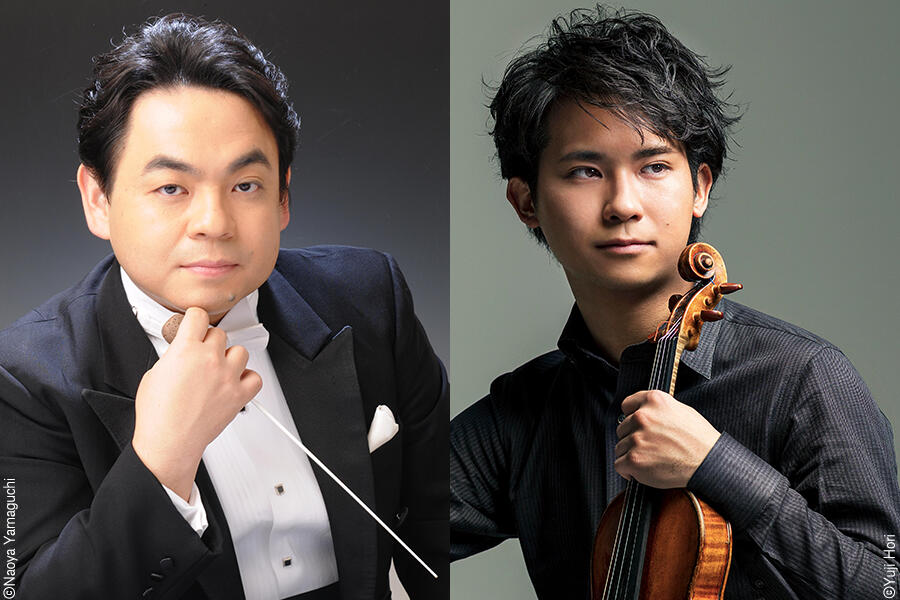
Program
Suppè / Leichte Kavallerie, operetta―Overture (Light Cavalry)
The present concert program casts a spotlight on the operetta which gained tremendous popularity in Europe from the mid-19th century through the mid-20th. Often comic, and composed of spoken dialogues, songs and dances, the operetta was established by Offenbach in Paris (discussed below). The genre quickly spread to Vienna and other European cities, and eventually developed into the musical.
Franz von Suppè (1819–1895) is considered the father of the Viennese operetta who paved the way for Johann Strauss II (1825–1899) and Franz Lehár (1870–1948). The son of an Austrian civil servant, Suppè was born in Spalato (then a part of the Austro-Hungarian Empire, now Split in Croatia) and took flute and composition lessons in his childhood. While he was a law student in Padua, he spent time in Milan where he met Rossini, Donizetti and Verdi, and heard Italian operas. After honing his composition skills in Vienna, Suppè served as a composer-conductor successively at leading theaters in the city for which he wrote many stage works. Overall, his compositions are marked by the marriage of Viennese fluent lightness and Italian tunefulness.
Suppè’s Das Pensionat (The Boarding School), premiered in November 1860, is regarded as the first true Viennese operetta composed following the latest trend in Offenbach’s operettas in Vienna since 1858. Noteworthy is that the successful Viennese premiere of Offenbach’s Orphée aux enfers(Orpheus in the Underworld) took place in early 1860.
The two-act operetta Leichte Kavallerie (Light Cavalry) was premiered in 1866 at Vienna’s Carltheater, then Suppè’s workplace. The slapstick story is set in an Austrian village: beautiful Vilma, raised as an orphan, finds out that her real father is Janos, one of the Hungarian hussars (lightly armed cavalries) visiting the village. The popular overture consists of contrasting five sections performed without break. The solemn beginning with a brass fanfare (A major) and the next fast section (A minor) are followed by the famous march evoking horse gallops. The next slower section immerses itself in a Bohemian-like elegiac atmosphere, before the finale has horse gallops return and closes the overture with a brilliant fanfare.
[Kumiko Nishi]
Saint-Saëns / Violin Concerto No. 3 B Minor Op. 61
Born in Paris, Camille Saint-Saëns (1835–1921) was a genuine musical prodigy who started composing at age 3 and made his official pianist debut at age 10. He then quickly came to fame: Berlioz (1803–1869) wittily commented on the talent of young Saint-Saëns, saying “he knows everything, but lacks inexperience.” Besides as a skillful composer, Saint-Saëns had an excellent reputation as an organist, and Liszt (1811–1886) famously hailed him “the greatest organist in the world.” Furthermore, Saint-Saëns was an enthusiastic supporter of other contemporary composers, conducting Liszt’s symphonic poems and defending music of Wagner (1813–1883) in France.
Through his own experiences as an interpreter, Saint-Saëns strongly sensed the necessity of a vigorous effort to boost his country’s instrumental music repertoire. In fact, operas, ballets and Austro-German music dominated the French classical music scene until then. That was a reason why he founded the Société nationale de musique in Paris together with Fauré (1845–1924) and Franck (1822–1890) in 1871 immediately after Prussia defeated France at the war of 1870–1871. This patriotic association aimed to encourage French composers to write more orchestral and chamber works. Saint-Saëns himself would act out penning the symphonic poem Danse macabre (1874), Symphony No. 3 “Organ” (1886) and various concertos to name a few.
Saint-Saëns composed the Violin Concerto No. 3 in 1880 in his mid-forties for Pablo de Sarasate (1844–1908). For this unparalleled virtuoso violinist from Spain, Saint-Saëns had written the Introduction and Rondo Capriccioso seventeen years earlier. The Violin Concerto No. 3 is distinguished by its clear structure encasing varied ingenious ideas in it. The orchestra sounds magnificent here and there in the first passionate sonata movement and the dramatic rondo finale full of variety. The middle movement, brimming with grace peculiar to French music, is a barcarolle (boat-song) as hinted by the 6/8 time at a moderate pace evoking Venetian gondoliers’ regular strokes. At the dreamy ending of this gondola ride movement, the violin solo plays with the flageolet technique to produce high, delicate, transparent tones.
[Kumiko Nishi]
Suppè / Dichter und Bauer, operetta―Overture (Poet and Peasant)
The present overture was composed as the incidental music for the comedy Dichter und Bauer (Poet and Peasant). It was premiered in Vienna in 1846—thus before the operetta was imported there from France—at the Theater an der Wien where Franz von Suppè (1819–1895) was working as the Kapellmeister. The story, set in Bavaria, features the young heroine Hermine. The title refers to the poet Ferdinand whom she loves, and a peasant whose daughter receives a passionate poem from Ferdinand. The overture’s seven sections of varied tempos and moods are performed without break. The introductory section is particularly well-known for its opening grave brass chorale and its extended folksong-like cello solo over harp, followed by the darker and blusterous next section. Later around 1900, Dichter und Bauer would be adapted into an operetta with Suppè’s original music.
[Kumiko Nishi]
Offenbach / Rosenthal / Gaîté Parisienne, ballet (Parisian Gaiety) (Excerpts)
Born in Cologne, Germany, Jacques Offenbach (1819–1880) moved to France as a teenage to improve his cello performance. Nicknamed “the Liszt of the cello,” he first played in Parisian theater orchestras and toured Europe as a virtuoso. He then began trying to find a way to create operettas and eventually owned a theater in Paris. His first large-scale attempt Orphée aux enfers (Orpheus in the Underworld) was such a hit in 1858 in Paris that this genre gained explosive popularity in France and abroad. Incidentally, Saint-Saëns quotes the famous French cancan dance from Orphée aux enfers in Le Carnaval des animaux (The Carnival of the Animals) (1886).
Offenbach’s operettas were usually based on well-known myths or tales, and caricatured the contemporary Establishment or society. His choice of the popular music-hall dance cancan for corrupt Greek gods, for example, is a pungent satire. The tuneful, incredibly cheerful music by the German composer (even though Offenbach was naturalized as a French), must have sounded fresh for the audience who was familiar with the existing French opéra comique growing more and more serious.
Prepared half a century after Offenbach’s passing, the ballet score Gaîté Parisienne(Parisian Gaiety) consists of highlights from his different operettas and opera. They were arranged for orchestra by the French composer Manuel Rosenthal (1904–2003) at the request of the ballet company Ballet Russe de Monte-Carlo that premiered the ballet in 1938 with Léonide Massine as choreographer. Ravel’s close pupil, Rosenthal displayed his ability as an imaginative orchestrator for this one-act ballet set in a Parisian chic café during Napoleon III’s Second Empire period (1852–1870).
For today’s concert, our conductor Tatsuya Shimono chose to perform excerpts. The buoyant Ouverture is from Offenbach’s operetta La vie parisienne (The Parisian Life), while the merry Polka (No. 2) is from Le voyage dans la lune (A Trip to the Moon). Timeless hits, the Quadrille (No.17) and Cancan (No. 18) from Orphée aux enfers are also heard. The conclusion is the exquisite Barcarolle (No. 23) in 6/8 meter at a moderate tempo (as with above-mentioned Saint-Saëns’ ) from an act set in Venice of Offenbach’s fantastic opera Les contes d’Hoffmann (The Tales of Hoffmann).
[Kumiko Nishi]
[Encore]
February 22:
Henry Vieuxtemps / Souvenir d'Amerique, on Yankee Doodle, Op. 17
Violin : Fumiaki Miura
Artists
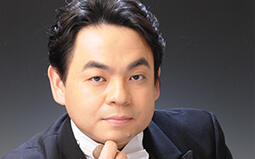 ConductorTatsuya Shimono
ConductorTatsuya Shimono
It was the year 2000 when Tatsuya Shimono came into our vision when he won 1st prize at the 12th Tokyo International Music Competition for Conducting (presently the Tokyo International Conducting Competition). The chairman of the jury was Yuzo Toyama, Principal Conductor of the NHK Symphony Orchestra, one of his predecessors. In 2022, almost a quarter of a century later, in his 6th year as General Music Director of the Hiroshima Symphony Orchestra (currently Conductor Laureate), Shimono founded The Next-Generation Conductors Academy and Competition. In 2024, it was renamed Hiroshima International Conductors Competition, and he appointed Christian Arming as the chairman of the jury, and Shimono himself became Music Producer for its parent organization, the Hiroshima Festival. He also serves as Music Director of the Hiroshima Wind Orchestra, while in a music program titled Suisogaku-no-hibiki (the Sound of Wind Music) on NHK-FM, presents the program with a fluent and skillful talk, almost equal to professional announcers. In the field of competitions and broadcasting, he is gradually inheriting Yuzo Toyama’s legacy.
His skillful approach to enliven music based on his sense of harmony and phrasing, which he sharpened during his study in Vienna, has been highly evaluated by orchestras all over the world, and his unique way of program-making has also garnered attention. In the NHK Symphony Orchestra’s February 2025 Subscription concert Program C, he will conduct a gorgeously lined-up program by contrasting the two operetta composers born in 1819, Suppè, who was born in Split (of current Croatia) and moved to Vienna, and Offenbach, who was born in Cologne and moved to Paris, and will add Saint-Saëns’ Violin Concerto No. 3 which the composer dedicated to the virtuoso Sarasate (which Fumiaki Miura performs).
[Takuo Ikeda, music journalist]
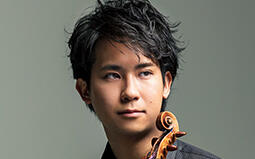 ViolinFumiaki Miura
ViolinFumiaki Miura
Fumiaki Miura is a violinist with a stunning aura. In the spring of 2024, he released the complete collection of Brahms sonatas (piano; Kazune Shimizu), and also performed with the Israel Philharmonic Orchestra in its subscription concert. Therefore, there is a high expectation for his appearance in the NHK Symphony Orchestra’s February Subscription concert of Program C in 2025 to play Saint-Saëns Violin Concerto No. 3, known as an elegant piece.
He studied violin with Pavel Vernikov in Vienna, and in 2009, at the age of 16, won the Joseph Joachim International Violin Competition Hannover, jumping on to the world stage. At the NHK Music Festival, he worked with the Los Angeles Philharmonic under Gustavo Dudamel to perform works by John Williams while was invited to the Royal Philharmonic Orchestra as its Artist-in-Residence for 2022.
In recent years, he has expanded his career as a conductor, and was warmly received for Brahms Symphony No. 1 with the City of Kyoto Symphony Orchestra. He is currently the Artistic Leader of Suntory Hall ARK Classics. In June 2024, he assumed the position of Music Director of the Miyazaki International Music Festival to succeed Tsugio Tokunaga, his mentor. He performs on the Guarneri del Gesu 1732 ‘Kaston.’
[Yoshimichi Okuda, music critic]
Download
Ticket
Program C
No. 2033 Subscription (Program C)
NHK Hall
Google Map
Seating Chart
Single Tickets Release Date
Pre-sales for Subscribers:Thursday, October 17, 2024
*about subscribers
Sale to General Public:Wednesday, October 23, 2024
Price
| S | A | B | C | D | E | |
|---|---|---|---|---|---|---|
| Ordinary Ticket | 10,000 | 8,500 | 6,500 | 5,400 | 4,300 | 2,200 |
| Youth Ticket | 5,000 | 4,000 | 3,100 | 2,550 | 1,500 | 1,000 |
Seating chart Enlarge Print PDF
*tax included
*Subscribers receive a 10% discount (Available at NHKSO WEB Ticket and N-Kyo Guide)
*For wheelchair-accessible seats, please refer to the N-Kyo Guide
Youth Tickets
Youth Tickets are great options for those of 29 years old and younger
Subscription tickets
Release Date
ANNUAL SUBSCRIPTION TICKETS
Mon., July 15, 2024 10:00am
[For Subscribers: Sun., July 7, 2024 10:00am]
SEASONAL SUBSCRIPTION TICKETS (WINTER)
Tue., October 15, 2024 10:00am
[For Subscribers: Thu., October 10, 2024 10:00am]
Where to buy
NHKSO WEB Ticket | Friday, February 21 (In English / Seats not selectable)
NHKSO WEB Ticket | Saturday, February 22 (In English / Seats not selectable)
NHKSO WEB Ticket (In Japanese only / Seats selectable)
N-Kyo Guide (Purchase by telephone only)
Other Ticket Agents
*Repertoire, conductor, soloists and program order are subject to change without notice.
*Pre-school children are not allowed in the concert hall

